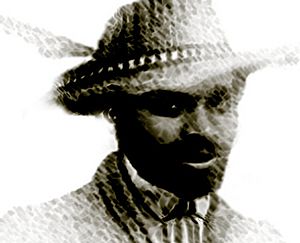Mathieu da Costa facts for kids
Quick facts for kids
Mathieu da Costa
|
|
|---|---|

An artist's impression of Mathieu da Costa
|
|
| Born |
Lusofonia
March 1 1589 |
| Died | after 1619 |
| Other names | Mathieu da Costa (sometimes d'Acosta) |
| Occupation | Translator and Explorer |
| Known for | First recorded black person in Canada, Exploration of New France, Bridge between the Aboriginal peoples in Canada and the European explorers through his translation |
Mathieu da Costa (sometimes d'Acosta) lived from about 1589 to after 1619. He was an Afro-French explorer and translator. He traveled with Pierre Dugua, the Sieur de Monts and Samuel de Champlain. They journeyed from France to the New World in the early 1600s. Mathieu da Costa was the first recorded free black person to arrive in what is now Canada.
Contents
Mathieu da Costa's Story
We don't have many records about Mathieu da Costa. We know he was at least partly of African background. Explorers liked him because he could speak many languages. Many people of mixed African and Portuguese heritage worked as sailors or interpreters back then.
A Gift for Languages
Mathieu da Costa was very good with languages. People believe he could speak Dutch, English, French, and Portuguese. He also likely knew Mi'kmaq and a special trading language called pidgin Basque. Many Aboriginal peoples used this pidgin for trading.
Working with the Portuguese
The Portuguese first hired Mathieu da Costa as a translator. He quickly learned their language. They thought his skills would be very useful for exploring new lands. Europeans had relied on such translators for over a hundred years. A person like da Costa, who translated and helped people communicate, was called um grumete by the Portuguese.
Later, both the English and the Dutch wanted his help. They needed him to talk with the Aboriginal peoples in North America. But the French managed to hire him instead.
Trouble in Holland
In February 1607, Mathieu da Costa was in Amsterdam, Holland. The Dutch had taken Pierre Du Gua de Monts's ships near Tadoussac. This happened during a trade disagreement on the St. Lawrence River. They also took Da Costa. This suggests that his language skills were very important. He could help bridge the gap between Europeans and the First Nations of Canada.
Exploring with the French
French documents show that da Costa worked for the leaders of Port Royal in 1608. He was hired by Pierre Du Gua de Monts for three years. It's likely that Da Costa went with Du Gua de Mons and Samuel de Champlain on their trips. They explored the Acadia and St. Lawrence areas.
However, in 1609, records show him in Rouen, France. He was also in a jail in Le Havre, France, in December. So, it's not clear if he visited Canada that year. Du Gua's work in Canada continued until 1617. A court case about da Costa's support went on until 1619.
Some people wonder how da Costa learned to speak with Aboriginal peoples. One idea is that trading centers in North America were similar to African trading ports. Both had many people who spoke different languages.
Mathieu da Costa's Legacy
Da Costa's amazing translation skills helped a lot. They made it easier for early French explorers to communicate with the First Nations. His work in Canada is remembered at the Port-Royal National Historic Site in Port Royal, Annapolis County, Nova Scotia. A French graphic novel, Mathieu de Costa, was also written about him. Diane Groulx wrote it, and Jocelyne Jatte drew the pictures.
Honoring His Memory
Many things have been done to remember Mathieu da Costa:
- Canada Post released a postage stamp honoring him on February 1, 2017. This was part of Black History Month.
- A special plaque at Port Royal, Nova Scotia celebrates his contributions. It is part of the Mathieu da Costa African Heritage Trail. This trail has monuments marking African Nova Scotian history in the Annapolis Valley. The plaque was revealed in July 2005.
- The Mathieu da Costa Challenge was a yearly contest. It started in 1996 by the Department of Canadian Heritage. This challenge encourages young people to learn how different cultures have shaped Canada's history. It also teaches them about the importance of diversity in Canadian society.
- A school in Toronto and two streets have been named after da Costa. One street is in Montreal and the other in Quebec City.
See also
- Black Nova Scotians
- Portuguese colonization of the Americas

